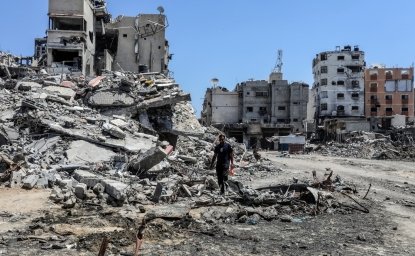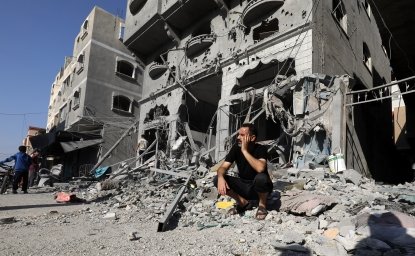The number of terrorist attacks in the Middle East and North Africa (MENA) declined significantly in 2018, according to the Global Terrorism Index, an annual study by the Institute for Economics and Peace. The security situation improved in 17 countries and only worsened in Iran and Morocco. The better conditions were largely driven by the deterioration of ISIS, which lost much of its territory in Iraq and Syria. “Deaths attributed to the group declined 69 per cent, with attacks declining 63 per cent in 2018,” according to the report. “The largest decline in fatalities last year was in Iraq, which had 75 per cent fewer deaths from terrorism in 2018. Syria followed, with nearly a 40 percent reduction.”
Despite the overall decline in attacks and fatalities, three MENA countries were among the top 10 countries most impacted by terrorism worldwide -- Iraq (1,054 deaths), Syria (662 deaths) and Yemen (301 deaths).
On December 10, the U.S. Institute of Peace (USIP) and the Institute for Economics and Peace hosted a discussion on the on the index and how the data can help shape counterterrorism policy.
Participants included:
Aleksandra Dier
Gender Coordinator, United Nations Counter-Terrorism Committee Executive Directorate (CTED)
Ryan Greer
Director, Program Assessment and Strategy at the Anti-Defamation League
Erin Miller
Principal Investigator, Global Terrorism Database, National Consortium for the Study of Terrorism and Responses to Terrorism
Serge Stroobants
Director of Operations, Europe & MENA, Institute for Economics and Peace
Leanne Erdberg, moderator
Director of Countering Violent Extremism, USIP
The following are excerpts from the report.
Middle East Regional Trend
The impact of terrorism lessened in seven of the nine world regions in 2018, in line with the global trend, which recorded a significant drop in both deaths from terrorism and terrorist attacks. The largest improvement occurred in MENA, while South America had the largest deterioration, followed by Central America and the Caribbean. Table 2.1 shows the regions of the world by their average GTI score for 2018, as well as changes in score from 2017 and from 2002, the first year of the GTI.
Between 2002 and 2018, South Asia, MENA and sub-Saharan Africa accounted for 93 per cent of all deaths from terrorism. The largest number was recorded in MENA, at more than 93,700 fatalities. South Asia recorded roughly 67,500 over the same period, with a further 45,000 occurring in sub-Saharan Africa.
The MENA recorded a substantial improvement last year with 17 countries improving, while only Iran and Morocco deteriorated. This is the third year in a row that the region has improved. Fatalities in MENA accounted for 42 per cent of the global total deaths from terrorism since 2002. However, since the defeat of ISIL the region’s share of the global total has dropped substantially, and in 2018, it accounted for only 15 per cent of total deaths.
The largest decline in fatalities last year was in Iraq, which had 75 per cent fewer deaths from terrorism in 2018. Syria followed, with nearly a 40 per cent reduction. The principal driver of these improvements was the reduction in attacks perpetrated by ISIL, which fell by 36 per cent in Iraq and 53 per cent in Syria from 2017 to 2018.
In December of 2017, Iraq declared that it had reclaimed the last ISIL territories on the Iraqi-Syrian border and the Russian military announced it had fulfilled its mission of defeating the group in Syria.
The fatality rate in Iraq per ISIL attack in 2018 fell to 1.6 people per attack, compared to 4.5 people per attack in 2017. More strikingly, in 2018, no attack killed more than 24 people while in 2017, 28 attacks resulted in 25 or more fatalities. The number of active groups in the country also fell from 12 to eight.
Conversely, in Syria in 2018, while there were fewer attacks overall, there were more active terror groups in the country and attacks by ISIL, while less frequent, these attacks were deadlier than in 2017. The number of active terrorist groups in 2018 increased to 14, compared to only eight in the prior year. Sixty per cent of attacks were attributed to these groups, while 40 percent were not claimed in 2018. The number of attacks by ISIL declined substantially, falling from 64 to 30, but the fatality rate of these attacks rose from 10.8 to 16 in 2018, a 48 per cent increase when compared to the prior year.
Lebanon, Bahrain, Kuwait, Egypt and Iraq had the largest improvements in score in the region. Terror attacks in Lebanon have fallen consistently since peaking in 2014, with only two deaths from five incidents recorded in 2018. In 2018, Lebanon did not record a single attack by ISIL, the first year since 2013.
Bahrain recorded one attack in 2018, down from 18 in 2017, while Kuwait has not recorded a single terrorist attack in the past two years. Egypt saw the number of terror attacks fall from 169 to 45, as a result of increased counter-terrorism activities directed at the Sinai Province of the Islamic State. Morocco and Iran were the only two MENA countries to deteriorate in 2018.
Morocco experienced one terrorist attack last year, its first since 2015. Two tourists were killed by Jihadi-inspired extremists who pledged allegiance to ISIL in a video. Previously ISIL had not been present in Morocco.
Country Profiles
Iraq
Iraq recorded the largest reduction in terror-related deaths in 2018. The number of deaths decreased from 4,271 in 2017 to 1,054 in 2018, marking a 75 per cent decrease. In 2018, terror related deaths reached their lowest level since 2003. There was also a fall in terror-related incidents, dropping to 1,131 from 1,956 in 2017. The lethality of attacks continued to fall significantly, with 0.9 deaths per attack in 2018, compared to 2.2 deaths per attack in 2017.
Both terrorism and battle-related deaths have fallen significantly since their peak in 2014, with both reporting a 90 per cent decrease. Since 2001, there have been 66,573 deaths from terrorism in Iraq.
Terrorist activity in Iraq has been dominated by ISIL since 2013. ISIL was responsible for 801 deaths from terrorism in 2018 or 76 per cent of total deaths in Iraq, with the remaining 24 per cent having unknown perpetrators.
Ongoing efforts by Iraqi and international forces have been effective in regaining former ISIL-held territory in Iraq. By the beginning of 2018, ISIL had lost approximately 95 per cent of its territory, including the strategic city of Mosul. In Mosul, ISIL-perpetrated attacks decreased by 95 per cent over the prior year, with just 12 recorded attacks in 2018.
In line with a decrease in ISIL’s terrorist activity, civilian deaths caused by ISIL also declined. In 2018, civilian deaths fell by 44 per cent from the preceding year. However, whilst the number of attacks on civilians declined, ISIL attacks on government targets doubled between 2017 and 2018.
Suicide bombings by ISIL followed a downward trend in 2018. Of the 506 attacks perpetrated by ISIL in Iraq, 33 attacks or seven per cent were suicide bombings, down from 20 per cent of attacks in 2017. In general, suicide bombings have declined by 85 per cent since they peaked in 2016. This decrease in suicide bombings has followed increased security measures and declining fighter numbers.
In 2018, ISIL perpetrated attacks in eight provinces across Iraq. Although most provinces across Iraq recorded a fall in attacks, Kirkuk reported a 127 per cent increase in terror-related incidents by ISIL between 2017 and 2018. The resurgence of violence in Kirkuk came as ISIL has conducted more bombings against civilians and police. Despite the fall in deaths from terrorism in 2018, ISIL remains a substantial threat. In Iraq, ISIL continues to operate in rural areas, including Anbar and Nineveh provinces, where it conducts kidnappings, assassinations and attacks on utilities.
Syria
Following a de-escalation of conflict in Syria, deaths from terrorism decreased by 40 per cent to 662 in 2018. Terror-related incidents fell to 131 in 2018, a nine per cent decrease from the preceding year. Whilst the number of deaths and incidents has steadily declined, Syria remains one of the worst ten countries for terror-related deaths in 2018.
The trend of reduced deaths reflects the decline in terrorist activity by ISIL, which is responsible for more deaths in Syria than any other group. In 2018, deaths attributed to ISIL reached their lowest level since 2013, and declined by 68 per cent since peaking in 2015. The Kurdistan Workers’ Party (PKK) and Hay’at Tahrir al-Sham (HTS) were the second and third deadliest groups in Syria in 2018, responsible for 20 and 11 deaths respectively. Collectively, these three groups accounted for 77 per cent of terror-related deaths in 2018.
Despite a decline in deaths attributed to ISIL, the group remained the deadliest in Syria for the fifth consecutive year. ISIL was responsible for 73 per cent of deaths from terrorism in Syria in 2018. Whilst deaths and incidents decreased, there was a significant increase in lethality of attacks by ISIL. In 2018, attacks by ISIL caused on average 16 deaths per attacks, compared to 10.2 deaths per attack in 2015.
Most deaths from terrorism in Syria have been from bombings, with the majority targeting civilians. In 2018, bombings accounted for 68 per cent of deaths. Syria recorded a 65 per cent decline in the number of bombings and explosions attributed to ISIL in 2018. Whilst the number of terror-related incidents fell, ISIL attacks on civilians became more deadly, with 25.1 fatalities per attack compared to 9.4 in 2017.
Terror-related incidents occurred in 11 of Syria’s 14 provinces, highlighting the wide-ranging impact of terrorism in the country. The majority of attacks occurred in Aleppo, at 36 per cent, followed by Idlib, Damascus and Dei res-Zor. In October 2017, the SDF regained the city of Raqqa, ISIL’s self-proclaimed capital. ISIL attacks in Raqqa declined by 95 per cent in 2018, highlighting the loss of its key territorial and logistical centre.
The province of As Suwayada saw the largest increase in deaths from terrorism and recorded 309 deaths in 2018, compared to only one death in 2017. The majority of the deaths were caused by 11 coordinated ISIL attacks that targeted the village of Al-Shibiki on 25th July 2018.
Effective counterterrorism measures and increased military pressure have reduced ISIL’s capacity to carry out attacks across much of Syria. However, even in the absence of territorial claims, ISIL remain the largest terrorist threat in Syria, and the region. Members of the group can be found across Syria, in provinces such as As Suwayda and Dier es-Zor, where they have resorted to guerrilla tactics against civilians and military personnel.
Yemen
Deaths from terrorism in Yemen fell for the fourth consecutive year, down 20 per cent from 2017 to 2018. This is an 80 per cent drop from the peak in deaths in 2015, which exceeded 1,500 fatalities.
Despite the significant decline in the impact of terrorism in recent years, Yemen remains entrenched in a prolonged civil war. The war has claimed over 91,000 fatalities since January 2015, with 2018 being the deadliest and most violent year on record. UN sources estimate that two million Yemenis have been displaced and the country driven to the brink of famine, describing the situation as “the world’s worst humanitarian tragedy.”
Terrorism in Yemen is closely linked to ongoing armed conflict. Yemen has suffered decades of low-intensity armed conflict since achieving independence. Violence escalated drastically in 2015 following the multinational intervention in support of ousted President Hadi after Houthi insurgents seized Sanaa.
Ansar Allah has become the deadliest terrorist group in Yemen since overtaking Al-Qa'ida in the Arabian Peninsula (AQAP) in 2015. Ansar Allah has been responsible for over 1,500 deaths since 2015. The group accounted for 56 per cent of attacks and 55 per cent of deaths in 2018 alone. Most of these attacks were perpetrated around and to the southwest of Sanaa in the governorates of Amanat Al Asimah, Al Hudaydah, and Taizz.
The year 2018 saw a continued decline in the activity of ISIL-affiliates in Yemen. Of the five ISIL-affiliates that have been active in Yemen in the past five years, only the Adan-Abyan Province of the Islamic State remains. The Adan-Abyan Province of the Islamic State was responsible for only two terrorist attacks in 2018, both in the southern governorate of Adan.
Al-Qa'ida in the AQAP remains in an active conflict with both the forces of ousted President Hadi and Ansar Allah, to which it is ideologically opposed.27 In 2018, AQAP was responsible for 19 deaths, down from 21 in the previous year. Most of these attacks were in the southern and central Hadramawt and Shabwah governorates and targeted other terrorists or non-state militia. AQAP activity has dropped by 88 per cent in Yemen since peaking in 2015, contributing to the recent decline in overall terrorism in Yemen.
Click here for the full report.

The Islamists
Learn more about Hamas and how it relates to similarly aligned organizations throughout the region. Read more

Explore More
Browse Insights & Analysis
Israel Escalates Attacks in Gaza: What’s Next?

Israel Expands Operations on Multiple Fronts: Perspectives on the Conflict

